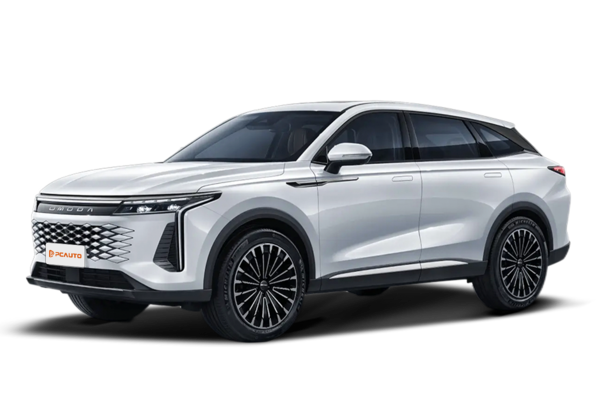Q
What's the interior capacity of the Omoda C9?
The Omoda C9 is a five-seater model, well-suited for most family trips and daily commutes. Its reasonable interior design provides comfortable accommodation for all five passengers. The front row seats the driver and one passenger, while the rear bench comfortably fits three adults.
With a 2,800mm wheelbase, the C9 offers ample legroom for rear passengers, significantly enhancing ride comfort. Additionally, the vehicle has a 660-liter trunk capacity that easily handles everyday needs - whether for loading groceries, luggage, or larger items like strollers - making it practical for both shopping and travel.
Special Disclaimer: This content is published by users and does not represent the views or position of PCauto.
Related Q&A
Q
Which segment is the Omoda C9 in?
The Omoda C9 belongs to the D-segment vehicle category. In terms of dimensions, it measures 4,775 mm in length, 1,920 mm in width, 1,671 mm in height, with a wheelbase of 2,800 mm - specifications that qualify it as a D-class vehicle. Such large dimension not only create a more spacious interior space for enhanced occupant comfort, but also give the vehicle a more substantial and sophisticated exterior presence. D-class vehicles typically represent elevated standards of quality and performance. The Omoda C9 shows this segment's advantages through its comprehensive safety package including eight airbags and multiple active safety systems, with premium comfort features such as power-adjustable seats and an expansive touchscreen display. These features align perfectly with D-segment positioning, delivering a high-end driving experience to consumers.
Q
Is the Omoda C9 an electric vehicle?
The Omoda C9 is not an electric vehicle. It runs on gasoline, powered by a 2.0-liter turbocharged four-cylinder petrol engine. This engine delivers a maximum output of 261 PS and peak torque of 400 N·m, paired with an 8-speed automatic transmission. The model offers two drivetrain options: front-wheel drive (2WD) and all-wheel drive (4WD).
For those who prefer traditional internal combustion engines, this powertrain configuration achieves an excellent balance between performance and driving dynamics. While electric vehicles are gaining popularity, the Omoda C9 is a good choice for consumers who still value the reliability and power delivery characteristics of gasoline engines.
Q
What's the size of the wheels of Omoda C9?
The Omoda C9 is equipped with 20-inch alloy wheels fitted with 245/50R20 tires on both front and rear axles. This tire specification is relatively common - the number 245 indicates the tire width in millimeters (with wider tires generally providing greater contact area and improved grip), while 50 represents the aspect ratio (the tire's sidewall height as a percentage of its width, with lower values indicating a "lower profile" tire that typically enhances handling at a slight compromise to ride comfort). The "R" denotes radial tire construction, and 20 signifies the 20-inch wheel diameter.
The larger wheel size significantly enhances the vehicle's visual appeal, giving it a more athletic and substantial appearance. Furthermore, properly specified tires play a crucial role in various performance aspects including handling, braking, and driving stability, enabling the vehicle to adapt to diverse road conditions and driving requirements.
Q
What's the size of the engine of the Omoda C9?
The Omoda C9 is powered by a 2.0-liter engine, specifically the 2.0TGDI 400T model, adopting turbocharged intake and an inline four-cylinder configuration. This engine delivers a maximum power output of 192 kW and peak torque of 400 N·m, delivering an impressive 261 horsepower. Its robust power delivery ensures excellent performance whether accelerating in urban driving or overtaking on highways.
Paired with an 8-speed automatic transmission, the powertrain provides smooth gear shifts that further enhance the driving experience. This engine specification gives the Omoda C9 competitive advantages in its segment, effectively meeting drivers' demands for dynamic performance.
Q
What's the trunk capacity of the Omoda 9?
The trunk capacity of the Omoda 9 is 660L, which adequately meets the demands of daily commuting and family use. Whether for routine shopping, loading luggage, or transporting sports equipment, it provides high convenience. Such trunk capacity not only facilitates travel but also enhances the vehicle's practicality. The rear seats of the Omoda 9 support a 60/40 split-folding function, allowing partial or complete folding to expand cargo space when transporting bulky items like furniture or bicycles. This design offers greater flexibility to accommodate diverse loading scenarios.
Q
What is the Ancap rating of the Omoda C9?
At present, there is no specific ANCAP rating information about the Omoda C9. However, judging from the vehicle's configuration, it is well-equipped with comprehensive safety systems, including standard ABS anti-lock brakes, electronic stability control, lane change assist, lane departure warning, autonomous emergency braking, and eight airbags (driver, front passenger, front side, front/rear curtain, and knee airbags), along with ISOFIX child seat anchors.
Typically, vehicles with such comprehensive safety configurations have a good chance of achieving good ratings in ANCAP and similar safety assessments. For the most accurate Omoda C9 ANCAP rating, it's recommended to pay attention to official announcements from ANCAP.
Q
What color is the Chery Omoda C9?
Sorry, there is no information about the color of the Chery Omoda C9, so I can't provide an accurate answer. Generally, there is a wide variety of color options for vehicles. Common basic colors include black, white, and gray. Black appears calm and dignified, white is simple and clean with high visibility at night, while gray is understated and dirt-resistant. There are also some distinctive colors, such as red, which shows vitality and passion, and blue, which exudes a sense of technology. If you'd like to learn about the specific color options for the Chery Omoda C9, I recommend visiting your local Chery dealership or checking Chery's official website and social media channels for detailed information on the model's available colors.
Q
What is the range capability of Omoda C9?
The range capability of the Omoda C9 varies across different versions. For the gasoline-powered model with a 65L fuel tank, while official range figures haven't been specified, practical estimates suggest approximately 500-700 km under mixed driving conditions based on the fuel consumption characteristics of its 2.0T turbocharged engine.
The plug-in hybrid variant offers a combined range of 1,500 km with up to 240 km of pure electric range. This performance level can meet requirements for both daily urban commuting and long-distance travel. The gasoline version suits users concerned about charging infrastructure availability, while the PHEV model addresses range anxiety while delivering energy efficiency - allowing buyers to select their preferred version according to individual needs and usage patterns.
Q
What engine is the Omoda C9 equipped with?
The Omoda C9 is equipped with a 2.0L four-cylinder turbocharged gasoline engine with a displacement of 1998 mL. The engine delivers a maximum horsepower of 261 PS (192 kW) and a peak torque of 400 N·m, adopting an inline (Inline-L) cylinder configuration. This powertrain provides powerful output, enabling easy acceleration in urban driving and effortless overtaking on highways. Paired with an 8-speed automatic transmission, it ensures efficient power delivery while offering smooth gear shifts for enhanced driving comfort. Both two-wheel drive and four-wheel drive variants adopt this engine platform, catering to diverse consumer needs for vehicle performance and usage scenario.
Q
What is the fuel efficiency of the Omoda C9?
At present, there is no official data about the fuel economy of the Omoda C9. However, the Omoda C9 is equipped with a 2.0L four-cylinder turbocharged gasoline engine paired with an 8-speed automatic transmission. Generally speaking, the fuel efficiency of such a powertrain configuration is influenced by various factors, such as driving habits, road conditions, and vehicle load. If the driving style is smooth, with a little of sudden acceleration or braking, and the vehicle is primarily driven on well-maintained roads, its fuel efficiency may be better; conversely, aggressive driving with frequent stops and starts will negatively impact fuel efficiency. Vehicles with different drivetrain configurations also vary in curb weight, which further affects fuel efficiency. The 2WD model weighs 1,786 kg, while the AWD model weighs 1,876 kg. The relatively heavier AWD variant may theoretically consume more fuel.
Popular Cars
Model Year
Car Compare
Car Photo
Latest Q&A
Q
How much did a new 2018 beetle cost?
The 2018 Volkswagen Beetle had a starting price range of approximately RM120,000 to RM180,000, depending on the trim and options. The entry-level 1.2 TSI Design model was the most affordable, while the top-spec 2.0 TSI R-Line version approached RM180,000—though final pricing could vary with optional extras and dealer promotions.
As a timeless classic, the 2018 Beetle kept its retro charm but packed modern tech like a touchscreen infotainment system and active safety features. Under the hood, buyers could choose between the fuel-efficient 1.2T or the more spirited 2.0T engine.
Fair warning: Volkswagen discontinued the Beetle in 2019, so you’ll only find it on the used market now. That said, its iconic design and nostalgic appeal still make it a hit among collectors. If you’re eyeing a pre-owned model, always check the vehicle history and maintenance records to snag a solid deal.
Q
What engine does a 2018 VW Beetle have?
The 2018 Volkswagen Beetle offered two gasoline engine options across different markets. The primary powerplant was a 1.2-liter TSI turbocharged inline-four, delivering 105 horsepower and 175 Nm of torque, paired with a 7-speed DSG dual-clutch transmission. This compact forced-induction engine struck a balance between urban fuel efficiency and strong low-end torque.
Higher-spec variants featured an optional 1.4-liter TSI turbocharged unit, bumping output to 150 horsepower. Both engines adopted direct fuel injection and belonged to VW’s widely used EA211 modular family, featuring modern tech like lightweight aluminum blocks.
Though retaining its iconic silhouette, this generation Beetle actually shared its underpinnings with the Golf, inheriting the brand’s proven front-wheel-drive architecture. This platform commonality also translated to easier maintenance, as local dealerships were well-versed in servicing these powertrains thanks to extensive parts sharing across VW’s lineup.
Q
What are the different models of the 2018 VW Beetle?
The 2018 Volkswagen Beetle comes in three main trims: Classic, Trendline, and Sport. All models are powered by a 1.2-liter TSI turbocharged engine delivering 105 horsepower, paired with a 7-speed DSG dual-clutch transmission—perfect for city driving with its nimble handling and solid fuel efficiency.
The entry-level Classic trim rolls on 16-inch wheels and features a basic multimedia system. Stepping up to the Trendline adds 17-inch wheels, fog lights, and chrome accents. The Sport trim leans into its name with 18-inch wheels, a sport-tuned suspension, and unique interior color options.
This generation keeps the Beetle’s iconic retro curves but modernizes them with touches like LED daytime running lights. Inside, you’ll find color-matched dash panels, and with 310 liters of trunk space, it’s more practical than most small cars in its class.
Since the Beetline was discontinued in 2019, the 2018 model stands as the last new generation, making it a rising collector’s item—especially the convertible, which holds strong appeal in the used market. For maintenance, stick to routine service every 15,000 km or 12 months, and regular 95-octane fuel is all it needs.
Q
Does the 2018 Beetle have Apple CarPlay?
The 2018 Volkswagen Beetle did come equipped with Apple CarPlay, integrated into its Composition Media infotainment system. This allowed iPhone users to seamlessly connect for navigation, music, and other apps. The system also supported Android Auto, catering to different smartphone users with its intuitive and responsive interface—definitely a plus for convenience on the road.
That said, some early-production 2018 models might require a software update to activate the feature, so it’s worth checking with an official dealer to confirm your car’s specs or available upgrades. Also, wireless Apple CarPlay wasn’t standard across all trims; it depended on the factory-installed options.
For fans of classic styling who still want modern tech, the Beetle struck a nice balance between retro charm and everyday usability. Competitors like the Mini Cooper offered similar connectivity, but let’s be honest—the Beetle’s iconic design was always its standout feature.
Q
What is the fuel economy of the 2018 Beetle?
The 2018 Volkswagen Beetle's fuel efficiency varies by powertrain. The 1.2L TSI turbocharged version delivers a combined fuel consumption of around 5.5L/100km, while the 1.4L TSI model is slightly thirstier at approximately 6.0L/100km – both perform best with 95-octane petrol.
You'll likely see higher consumption in city driving, but it cruises efficiently on highways thanks to its classic aerodynamic design. For better mileage, stick to routine maintenance like cleaning the air filter and keeping tyres properly inflated. These small habits can help squeeze out extra kilometres per litre.
Though discontinued, the 2018 Beetle remains popular in the used car market – its iconic styling and decent fuel economy make it a practical daily driver. Just remember real-world figures depend heavily on driving style and road conditions, so check owner forums for real-life feedback.
View MoreRelated News

November 2025 Malaysia B-Segment SUV Sales: Proton X50 ranks champion again with 2,123 units sold
Kevin WongDec 12, 2025

Chery launched a car that can drive on water, JETOUR Zongheng G700 unveiled
MichaelOct 22, 2025

The Tiggo 7 PHEV, conversely, gains traction among younger buyers by offering a lower price point and a more technologically advanced package.
JamesOct 15, 2025

Chery successfully listed on the Hong Kong Stock Exchange, which may accelerate its globalization in the future?
JamesSep 26, 2025

Chery Tiggo Cross launched in Malaysia 1.5T and hybrid model analysis, a new compact SUV option starting from 88,000
JamesSep 12, 2025
View More












 Cars
Cars




Pros
Cons